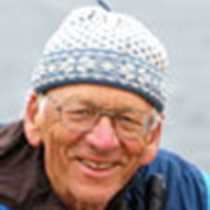Northern Drake Passage
On the flight from Santiago to Ushuaia, the weather conditions of the near future were a common topic of discussion. Looking out the window as the plane first landed at Punta Arenas and then finally to the small airstrip in Ushuaia, the clouds were parted enough to see a lush landscape covering the rugged mountainous terrain. Some also noticed that there were white caps being whipped up by a stiff westerly wind through the Beagle Channel. After going through formalities at the small airport then boarding comfortable coaches for a ride to the end of the road, we walked to a small catamaran waiting to take us on a ride in the famous Beagle Channel. En route we started getting aquatinted with each other as well as enjoying a refreshing lunch. Slowing down we were able to have our first wildlife encounters by getting close to shore. King cormorants, blue-eyed shags, kelp gulls, and other birds shared the small islets with southern sea lions. Then we were back to the waterfront and dock of Ushuaia where we also found our home for the voyage, the National Geographic Endeavour. Soon we were underway easterly in the Beagle Channel before turning in the middle of the evening setting a course SOUTH!
Reputations are sometimes unfounded for various reasons, however to sailors one of the most notorious sections of the world’s oceans is the Drake Passage. Since meeting in Santiago a topic of discussion and question was what to expect. At least for this day of transit, The Passage’s reputation was some what upheld. A strong westerly wind created swell and waves. Some on board found the slow rolling and movements of the ship a little too difficult to manoeuvre, but after a few hours of getting sea legs, people started appearing on deck and in the lounge. This transiting period southward gave us time to learn from Steve MacLean about the Southern Ocean and its characteristics that make it one of the most productive areas of the world’s oceans. Then Karen Copeland gave us pointers on how to maximize the chance to get better photos of our upcoming experiences.
Looking out a window or venturing out on the back deck provided us with a chance to see some of the ocean wanderers that make the Southern Ocean their home. Probably most exciting for many were the Wandering Albatross swooping along low over the swells. This kind of weather and waves is normal every day “life” to these seabirds. The size and mass of the albatross was surprisingly in contrast to the small size of a few other birds such as the Broad-Billed Prion a distant relative to the albatross. The seabird family known as tubenoses has its greatest diversity in these southern waters. Through the afternoon and evening the winds and waves gradually subsided and most fell fast asleep having experienced at least some of the well known reputation of the Drake Passage.
On the flight from Santiago to Ushuaia, the weather conditions of the near future were a common topic of discussion. Looking out the window as the plane first landed at Punta Arenas and then finally to the small airstrip in Ushuaia, the clouds were parted enough to see a lush landscape covering the rugged mountainous terrain. Some also noticed that there were white caps being whipped up by a stiff westerly wind through the Beagle Channel. After going through formalities at the small airport then boarding comfortable coaches for a ride to the end of the road, we walked to a small catamaran waiting to take us on a ride in the famous Beagle Channel. En route we started getting aquatinted with each other as well as enjoying a refreshing lunch. Slowing down we were able to have our first wildlife encounters by getting close to shore. King cormorants, blue-eyed shags, kelp gulls, and other birds shared the small islets with southern sea lions. Then we were back to the waterfront and dock of Ushuaia where we also found our home for the voyage, the National Geographic Endeavour. Soon we were underway easterly in the Beagle Channel before turning in the middle of the evening setting a course SOUTH!
Reputations are sometimes unfounded for various reasons, however to sailors one of the most notorious sections of the world’s oceans is the Drake Passage. Since meeting in Santiago a topic of discussion and question was what to expect. At least for this day of transit, The Passage’s reputation was some what upheld. A strong westerly wind created swell and waves. Some on board found the slow rolling and movements of the ship a little too difficult to manoeuvre, but after a few hours of getting sea legs, people started appearing on deck and in the lounge. This transiting period southward gave us time to learn from Steve MacLean about the Southern Ocean and its characteristics that make it one of the most productive areas of the world’s oceans. Then Karen Copeland gave us pointers on how to maximize the chance to get better photos of our upcoming experiences.
Looking out a window or venturing out on the back deck provided us with a chance to see some of the ocean wanderers that make the Southern Ocean their home. Probably most exciting for many were the Wandering Albatross swooping along low over the swells. This kind of weather and waves is normal every day “life” to these seabirds. The size and mass of the albatross was surprisingly in contrast to the small size of a few other birds such as the Broad-Billed Prion a distant relative to the albatross. The seabird family known as tubenoses has its greatest diversity in these southern waters. Through the afternoon and evening the winds and waves gradually subsided and most fell fast asleep having experienced at least some of the well known reputation of the Drake Passage.



